Introduction
Hey everyone! We are back to share with you more of our exploration on how we will solve food waste!
These past weeks our team started to create more ideas on how we will tackle the problem of food waste in Australia. Every week we learned very useful topics to aid us brainstorm cool and creative design concepts that will hopefully fit in society’s future.
We as a team, made lots and lots of idea napkins and did bunch of weekly meetings to create prototypes to help us share our ideas in class. We would be very happy to show you our design festival journey and the ideas we came up with here in our blog so keep on reading!
Futures and Foresight
The first topic that we had went back to is the discussion about the future! In our class, we learned that we can’t decide what is going to happen and then design something based on what you predict. The thing is, we shouldn’t be predicting but instead we should be anticipating. It is highlighted to us that we should “think about things more deeply over the longer term” (Nerd Nite, 2022). Therefore, by having ourselves think in this manner it helped make our “what ifs” seem more possible ahead of time.
To back up our ideas for the future we looked at current trends in terms of technology and methods that minimise food waste that may continue to improve or possibly evolve in the long run. An example of this is the constant development of smart fridges where this year Bespoke x Samsung Family Hub (4 Door Refrigerator) will now have artificial intelligence (News Samsung, 2023). It’s initial launch will be able to read around 33 different kinds of fruits and veggies and more will be added as the software updates overtime. This helps users to be reminded of food that are soon to expire in their stock.
Community Garden
One of the first prototypes that we did is combining advanced technology to community gardens as we learned that this is a food system that is being done currently in some parts of Victoria.
Using lego to represent our idea, we designed community gardens which we imagine are going to be located around the city of Melbourne where laneways have vertical farming setups. We envision our community garden where people come together and volunteer in maintaining plants and harvests that are installed on building walls. Along with the volunteers, we included drones with artificial intelligence that takes care of the plants placed higher on the walls. Additionally, volunteers receive fresh produce from the community garden and could receive more by bringing compost as fertilizers for the harvest.
We see value with this idea because it has a community factor that shows togetherness and cooperation of society. However, we have to rethink on how we would be able to make this idea interest a wider range of users as vertical farming not be fully accepted by residents staying in the area. Additionally, vertical farms are quite common these days and this implies we should probably think more futuristic and radical with our concepts.
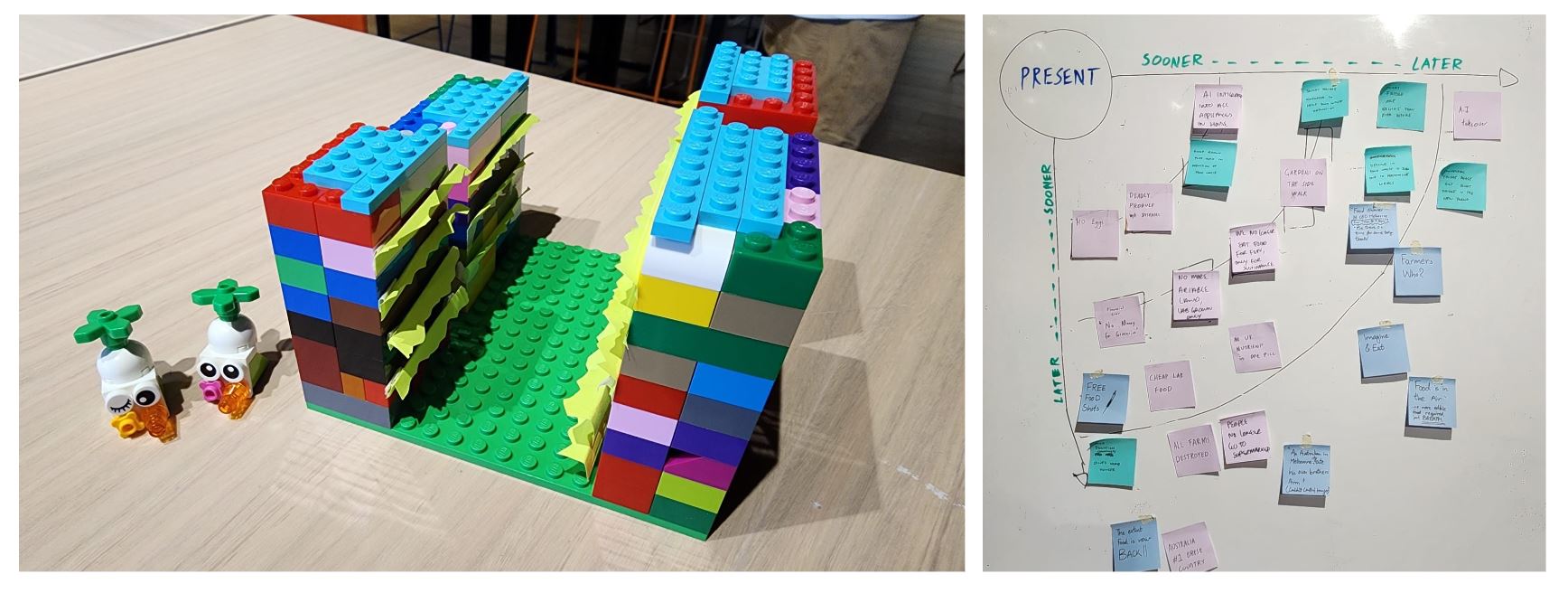
Eye Lens
The Eye tech Lens is a bio tech using contact lens that can scan your body’s nutrient levels and convert them into stats that can be seen with your eyes.
Using a bio scanning tech with A.I, a person’s nutrient levels are converted into game statistics such as strength, speed etc. If a person wants to increase their stats, then the A.I would recommend recipes or food and create a weekly meal plan to increase the statistics.
These statistics will be viewable through an ingrained eye tech piece that will show a status window through a holograph (Ex. Apples eye wear)
Behavior Change
The purpose of this idea was to encourage users to take a healthier lifestyle of eating. This idea was based on the topic of behavior change – to changes a person’s behavior for the better. However, this idea did not meet the criteria for behavior as it did not target a specific intervention point. Therefore, we reiterated this idea to include these features:
- Shopping
- Users will be noticed by the tech for healthier alternatives at the point when the user picks up an item
- Throwing soon-to-expire produce
- The eye tech will inform the user whether the produce is actually inedible, therefore, it avoids potential food waste
- If the user is unable to use the produce, it can show who else can use it.
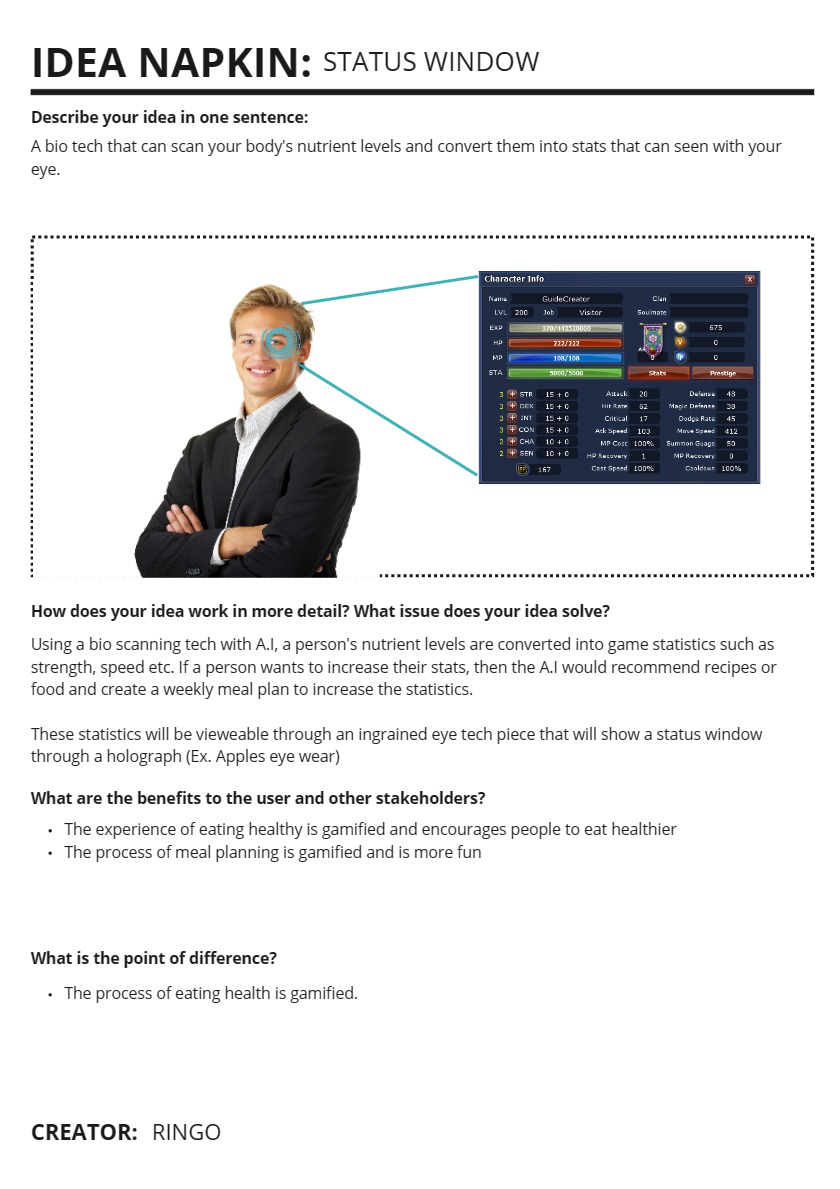
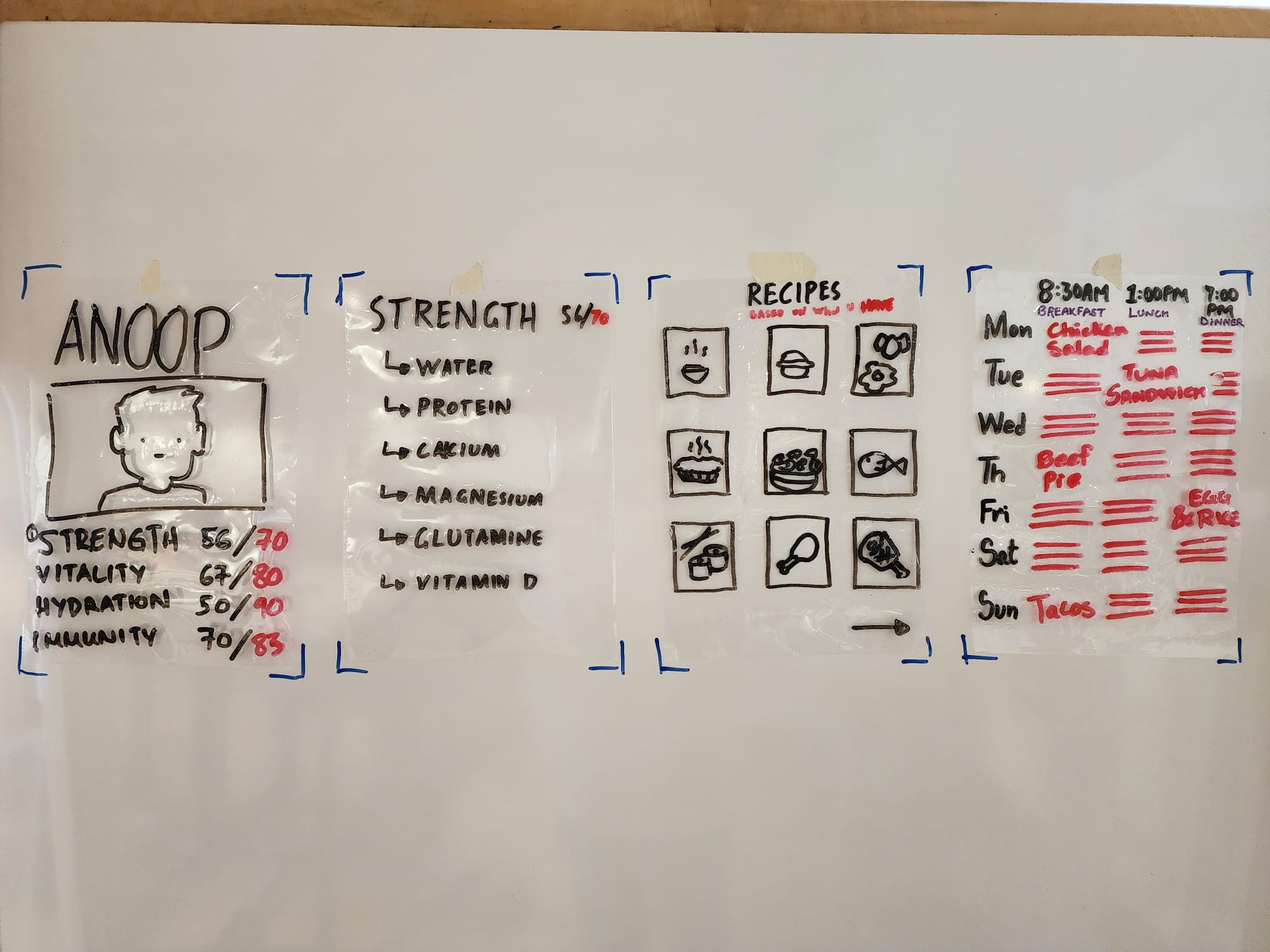
Planet Centric Design
We decided to further develop this idea to relate to planet centric design. This concept involves looking into how a solution can be part of a regenerative and sustainable system. To apply this concept to our idea, we looked into the disposal of the eye tech lens.We didn’t want our technology to be like an iphone that would be regularly disposed for a newer version. Therefore, we created a system that allows the user to update and recycle their tech. This system is conveyed through a storyboard we created below.
One significant shortfall of this idea was that this idea is too futuristic. We don’t know what materials may go into the technology. Therefore, it is difficult to create a recycling system. The suggestion we received was to take a step back and look at what may come before this contact lens technology so that it may be more tangible.
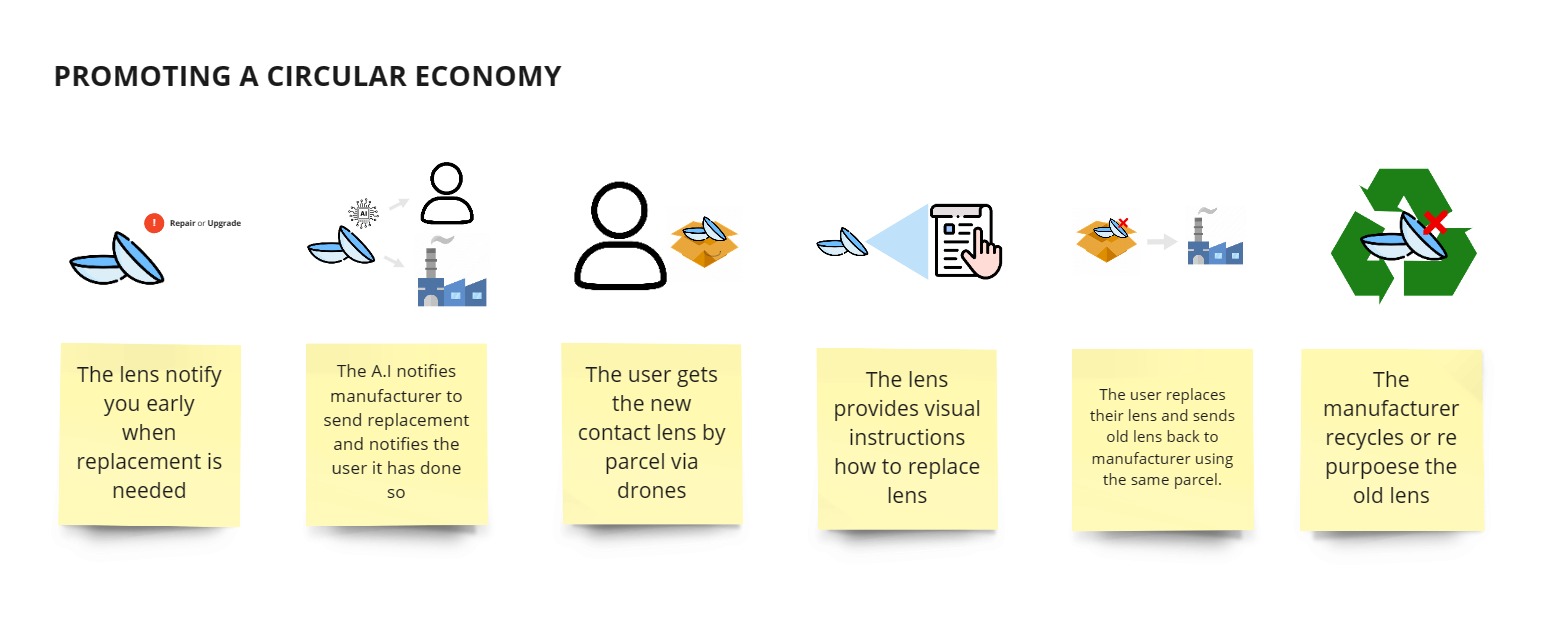
Service Design
In preparation for our talk with a guest speaker, Adam Cochran (service designer), we once again developed our eye tech lens to understand the user’s experience through a service blueprint.
The service blueprint was an insightful tool that allowed the team to identify the strong and weak points of our idea. One significant improvement to this idea was to look into the support processes needed for the eye tech to function. For example, we needed to consider how we were going to support the logistics of the programming and whether we seek needed health practitioners to help with meal planning.
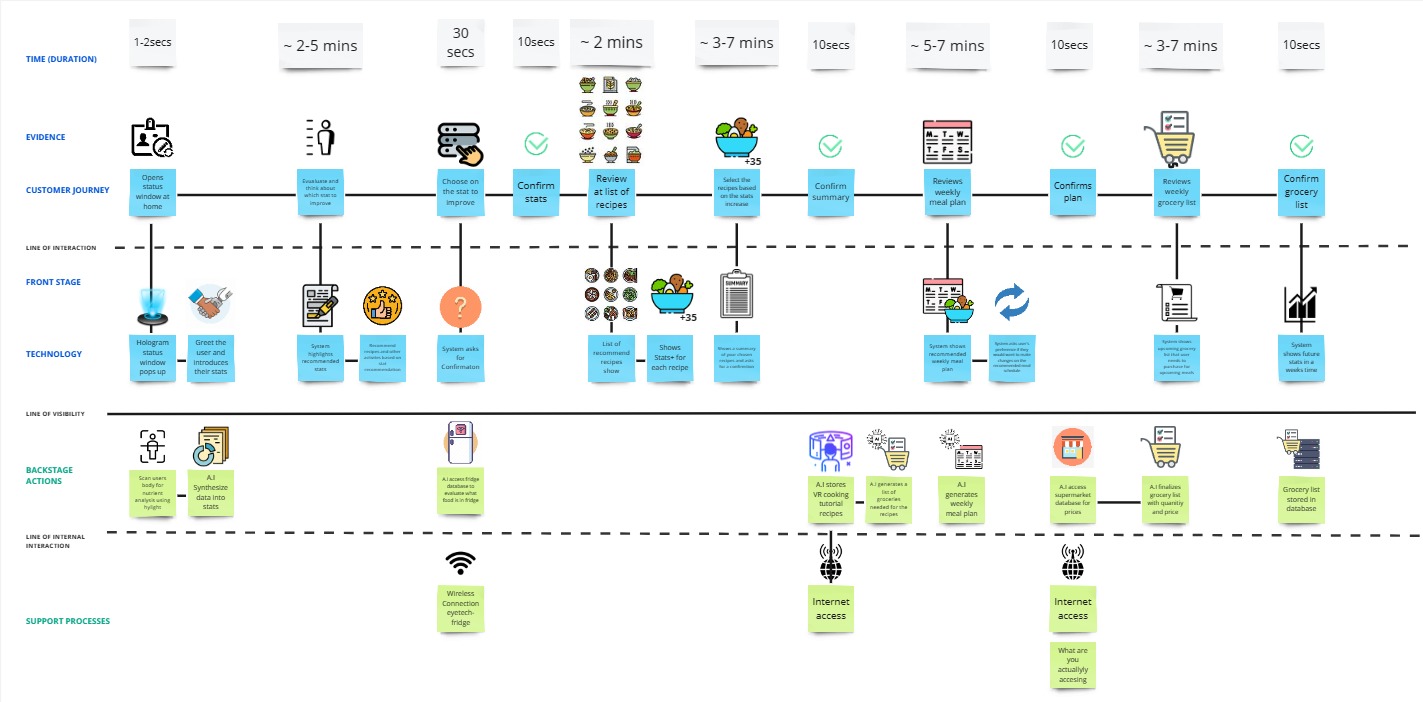
Community Kitchen
Through iterative exploration in service design, we prototyped the concept of a Community Kitchen, aimed at reducing food waste while providing affordable and nutritious meals to the local community. The meals are sourced from supermarkets that have their produce and ingredients expiring soon. Through an app, the community is notified of weekly dinner plans, enabling efficient planning through RSVPs. Advanced technology such as robot arms ensures precise ingredient measurements while composting cooking scraps transforms waste into energy resources. Participants earn discounts by bringing food waste from their households for composting, promoting sustainability within the community. Overall, the concept encourages community cohesion, offers affordable meals and promotes environmental awareness to tackle food waste.

Service Design Prospect:
- Community Engagement: The core of the idea revolves around community engagement. It brings people together to eat in a common space, by fostering a sense of belonging and shared responsibility towards reducing food waste.
- Technology Integration: The use of advanced technologies such as robot arms for precise measurements and ingredients enhances efficiency and reduces human error. This aligns with service design principles of optimizing processes for better user experiences.
- Resource Utilization: Turning food scraps into energy resources is a sustainable way to manage waste, highlighting the significance of environmentally responsible practices in delivering services.
- Communication and Transparency: The use of an app to notify the community about weekly dinner plans enhances communication and transparency. The RSVP system ensures better planning and minimizes food waste by preparing only what’s necessary.
Feedback and improvements:
In response to feedback received, it became clear that our community kitchen idea lacked a futuristic dimension essential for its alignment with the future vision of 2030. Incorporating advanced technology was crucial for improvements needed to build up the project’s viability and relevance. Thus, emphasizing the futuristic aspect was important to identify the full potential of our community kitchen concept and ensuring its sustainability and effectiveness in the future.
In conclusion, the Design Festival was a valuable learning experience where we explored innovative solutions to address household food waste. Through ideation and experimentation based on various design principles, we gained insights into user needs and behaviors.
Throughout the Design Festival targeting household food waste, our team delved into various design principles like service design, planet-centric approaches, and behavior change strategies. Through this process, we learned the importance of understanding user needs, promoting environmental consciousness, and influencing behavioral shifts. Moving forward, our plans include refining the most promising ideas, testing them and iterating based on the feedbacks received. We aim to develop practical and impactful solutions that make a positive impact on reducing food waste in households while considering user engagement and sustainability.
References:
www.youtube.com. Nerd Nite, (2022). Futures Thinking for Postnormal Times | Why Most Prediction Don’t Come True. [online] Available at: https://www.youtube.com/watch?v=31fEmEEQmn8&t=2s news.samsung.com.
(2023). Samsung Electronics To Showcase How Enhanced AI and Connectivity Enable Expansive Kitchen Experiences at CES 2024. [online] Available at: https://news.samsung.com/global/samsung-electronics-to-showcase-how-enhanced-ai-and-connectivity-enable-expansive-kitchen-experiences-at-ces-2024
Team Snapshot
Highlight:
The design fiesta was very much challenging but we were able to expand our thoughts more through looking at our chosen problem in different angles. At some days, our brains have ran out of ideas but the topics, thinking exercises and toolkits guided us to critically think before we design and flesh out ideas more responsibly. We believe that we can come up with a good and final solution as long as we just do it one at a time.
Quote of the week:
I stand up next to a mountain and I chop it down with the edge of my hand – Jimi Hendrix
Next Steps:
Now that we learned a lot from different topics and have viewed different angles to solve food waste with the aid of prototypes, the next thing to do is to gather all the most effective solutions and merge them to one final concept.

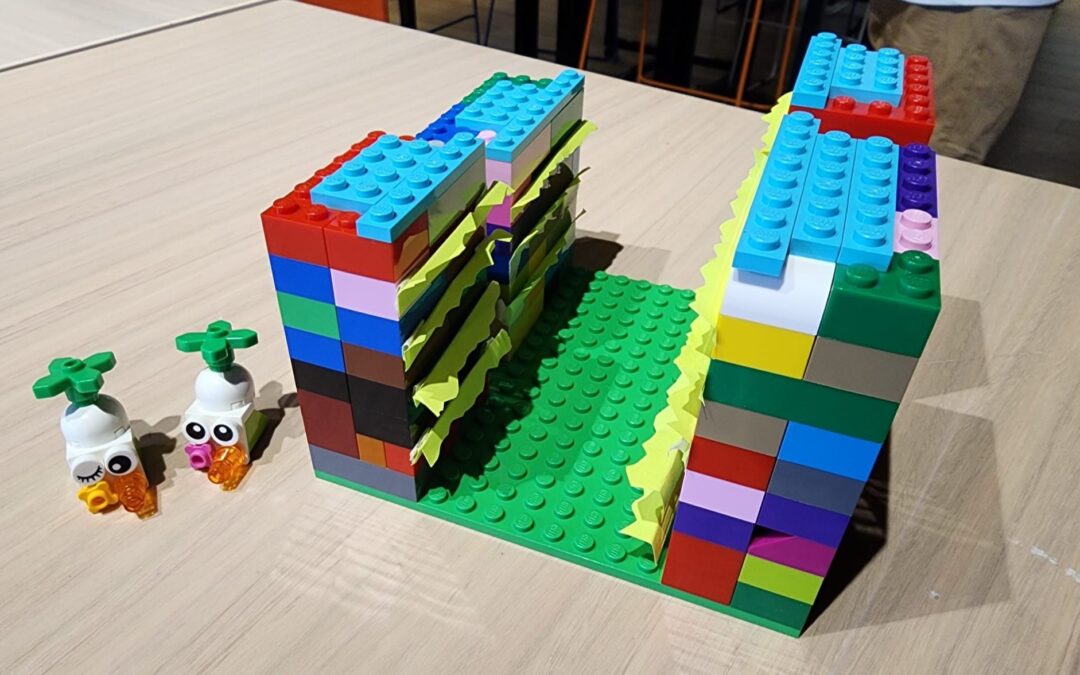
Recent Comments